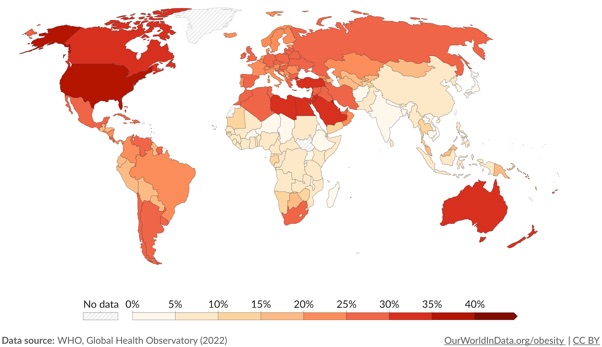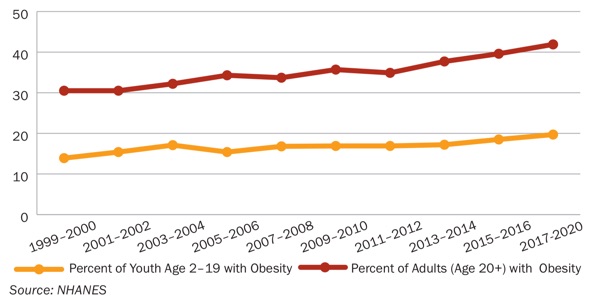News
download pdf file: Obesity.pdf
8 November 2023
Obesity is on the rise everywhere in the world
When they hear the word “malnutrition”, most people first think about “hunger”. This is not a surprise as undernourishment, hunger and famine have made the headlines for decades.
A global issue
Realty is changing, however. While there are still hundreds of millions of people who do not eat sufficiently to meet their caloric needs, the striking news of these last decades has been the surging number of people who, because they consume too much food or have an unbalanced diet, are overweight and, increasingly, obese1, with dramatic consequences on their health (diabetes, cardiovascular diseases and cancers) and life expectancy. And this affects around 2 billion people!
Undernourishment and unbalanced diets (in quantity and quality) leading to overweight are nowadays the two major dimensions of malnutrition.
Overweight and obesity may be less spectacular than devastating famines, but they are responsible for millions of deaths every year and have a huge social cost [read].
Figure 1 shows the distribution of adult obesity in the world, based on World Health Organization (WHO) estimates. As can be seen, obesity is observed throughout the world, although prevalence is higher in rich countries.
Clearly, obesity has become a global challenge.
Figure 1 Prevalence of obesity in adults, by country (2016)

In 2016, the highest prevalence was found in the Pacific Islands (more than 40% of adult population - more than 60% in Nauru) and lowest in Africa (around 5%). In Asia rates were low (lowest in the world being Viet Nam with 2.1%), while in Europe, prevalence was ranging between 20% and 30% (23.2% in France). In the US the share of obese adult population was 37.3% [check WHO estimates for your country].
Obesity is growing in both rich and poor countries
The diagrams in Figure 2 below show the rapidly growing share of world population suffering from obesity, with striking differences between the Americas, the Middle East and Europe, where the prevalence of obesity is high, and Africa, Asia and the Pacific regions (that includes East Asian countries like China) where it is yet low, but following an upward trend.
Everywhere, obesity is on the rise, constituting probably the most striking change in the field of food in the recent two or three decades. In fact, in 2016, more than 1.9 billion adults (more than 18 years old) were overweight (39% of total), of whom 650 million were obese (13% of total) [read].
Figure 2 Prevalence of obesity among adults (age 18 years or older),
in WHO regions, 1975–2016

Source: WHO, 2023
In the US, for example, adult obesity reached more than 40% of the population during the period 2017/2020, while youth obesity was around 20%, the share of the population concerned increasing quite regularly between 1999 and 20202 (Figure 3).
Figure 3 Percent of Adults and Youth with Obesity in the US, 1999–2020

Source: Trust for America’s Health, 2023
Causes of obesity
Poverty is often mentioned for explaining obesity. However, the relationship between obesity and poverty is nuanced and complex and depends on the income category of country considered.
In low- and middle-income countries, being poor is usually associated with undernutrition, while obesity is found mostly in middle and upper classes of the population, particularly in urban areas and for women, and is spreading progressively to all population groups. In
India, for example, a study measured that the overweight prevalence among women of reproductive age in urban centres had risen from 23% in 2005 to 33% in 2019-21, and that this increase was especially pronounced among scheduled castes and scheduled tribes women and women with lower educational level [read], while prevalence among women in the country as a whole, was only 4.9% in 2016 (and 2.7% for men), according to WHO estimates.
In rich countries, being poor frequently implies a greater risk of obesity [read here p. 2 and here]. In the US, for instance, ethnic minorities and populations with the least education and highest poverty rates bear the largest burden of obesity. In addition, disparities in obesity tend to be gendered, with women experiencing the strongest disparities in obesity by income, education, and race/ethnicity [read here and here].
A recent literature review [read] attempts to identify factors that play a role in the development of obesity. They include among others:
-
•Level of income per capita;
-
•Inequalities;
-
•Reduced physical activity;
-
•Presence of added sugar in processes food, particularly in beverages;
-
•Presence of added vegetable oils in processed foods;
-
•Prestige of unhealthy and cheap foods such as sweet beverages, highly processed industrial food and junk food/snacks [read];
-
•Contamination, especially by Persistent Organic Pollutants (POPs) that accumulate in the environment and seem to disrupt endocrine functions.
The review also highlights the need for more research to better understand mechanisms at work.
Conclusion
Obesity has become a major global challenge with considerable negative impact on health and life expectancy.
Poverty in rich countries, urbanization and lifestyle in low- and middle-income countries are the main factors of obesity.
There is yet more research needed to better understand causes of obesity and inform policies to address effectively the issue. The package will certainly have to comprise courageous measures to regulate food, as well as programmes to increase awareness of the problem among the population, including through school programmes and general sensitization campaigns.

------------
Notes
-
1.Overweight and obesity are defined according to the value of the Body Mass Index (BMI). The BMI of a person is equal to the weight in kilogrammes divided by the square of the height in metres. Overweight: BMI greater than or equal to 25. Obese: BMI greater than or equal to 30 [read].
-
2.In the US, “adults” category comprises people aged 20 and above, while “youths” comprise people aged between 2 and 19.
———————
To know more:
-
•WHO, World health statistics 2023: monitoring health for the SDGs, Sustainable Development Goals, World Health Organization, 2023.
-
•Trust for America’s Health, The State of Obesity: Better Policies for a Healthier America 2023, 2023.
-
•Hove T, Hermine, Guo X., Bakker S., Herens M., Addressing overweight and obesity in LMICs in rural development and food systems; A comprehensive literature review, Wageningen Centre for Development Innovation, Wageningen University & Research. Report WCDI-23-238. Wageningen, 2023.
-
•Huang y. and Sparks P. J., Longitudinal exposure to neighborhood poverty and obesity risk in emerging adulthood, Social Science Research,Volume 111, 2023.
-
•Lee, H. Inequality as an Explanation for Obesity in the United States, Sociology Compass, Volume5, Issue3, 2011.
Selection of past articles on hungerexplained.org related to the topic:
-
•Opinions: Address Malnutrition, Not Just Food Security by Jomo Kwame Sundaram, Wan Manan Muda and Tan Zhai Gen, 2019.
-
•Opinions: Beware High-Fat Diets by Wan Manan Muda and Jomo Kwame Sundaram, 2019.
-
•$1.2 trillion annually, is the estimated cost of obesity by 2025, unless proper action is taken, 2017.
-
•Opinions: Sweetened Research, Sugared Recommendations by Jomo Kwame Sundaram and Tan Zhai Gen, 2017.
Last update: November 2023
For your comments and reactions: hungerexpl@gmail.com


